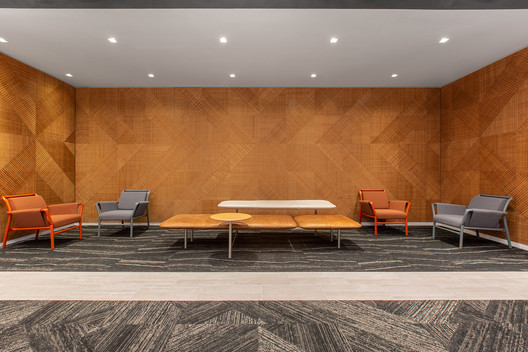
Linear patterns in interior spaces are prevalent throughout northern and western Europe. Not only to create texture but also to define space and direct the eye. Here in New York, 3-dimensional walls, ceilings, and surfaces are being utilized more and more to add contrasting form and scale to interior spaces. Moreover, the current obsession with anything mid-century modern has led to a resurgence of linear and slatted pattern-making in many forms.

With recent broadened accessibility to CNC routing and digital fabrication, manufacturers can more quickly fulfill designers visions by carving patterns into a wide range of materials and substrates.
Bamboo and Palm manufacturers Smith and Fong have been creating Plyboo® panels for over 25 years. These “multilayer cross-ply” laminated bamboo “plywood” panels have long been a darling among architects for their clean looks and signature stacked edge that requires no edge banding. About 4 years ago, co-owner Angus Stocks began developing a Collection of Plyboo® panels which are routed in unique, proprietary designs to reveal layers of material with depth and texture that is far greater than traditional plywood or fiber boards. Due to its unique construction, the Plyboo® material lends itself perfectly to geometric patterns. Smith and Fong’s dense, select grade Realcore™ by Plyboo® is engineered specifically for carving because it is consistent throughout and does not have voids or undesirable color variations often seen in common plywood or MDF board.
.jpg?1563397501)
.jpg?1563397527)
A longtime favorite in residential environments, designer Craig Wroe utilized the graphic textile-like LL4 design by Plyboo® in the 380 condo development. "In designing the lobby for 380 NWK at 380 Newark Avenue, my goal was to create an inviting space," says Wroe. "I used Plyboo® to give dimension and texture to the surrounding walls and to evoke a woodland setting. These elements provide an inviting escape from the hustle and bustle of the world outside. The Plyboo® evokes the beautiful, exotic forests of Asia. These elements create a feeling of comfort, warmth and “home” for buyers from throughout the world."
Using sustainable fire retardant treatments, Plyboo® panels can be made in ASTME 84 class A or B making them ideal for commercial ceilings and walls. For this elevator lobby in a financial firm's headquarters in New York City Vocon designer, Melissa Gambino developed a custom contrasting color technique to accentuate line weight as a form of gradation for elevator lobbies.
.jpg?1570228765)
The custom application of two different finishes along with the linear pattern represents the dynamic textures and contrast between hard line and organic elements of the city. As you arrive at each floor, the scale of the texture changes as a way to pull you into the space towards the views of Manhattan.

After mastering linear pattern in a typical 4’x8’ format, Angus Stocks developed two different online design tools that enable modular systems, allowing designers to configure tiles of different colors and patterns into countless quietly simple nested geometries or bold dimensional features.
For RXR’s offices, TPG utilized Fractal™ by Plyboo® to create warmth and geometry into an otherwise sleek environment. “Our goal for the project was to create a tenant amenity space to get away and take a quick phone call," says lead architect Doug West. “We chose the Fractal™ by Plyboo® panels because they add geometric interest and warmth to the room. Both TPG and RXR liked the modern sensibility and dimensional texture inherent to the panel design, different from other options on the market.”
Bamboo’s inherent superior flexural strength allows Plyboo® panels to be perforated to the point of removing up to 50% of material while maintaining structural integrity. Integrating perforation allows sound and light transmission for even greater visual appeal as well as acoustical performance. Not unlike early pop art paintings, one can find secondary and tertiary patterns within the panels that seem to vibrate when the natural silica-rich material reflects light.
When backed with sound absorbing materials, Plyboo® Sounds Panels can meet up to an impressive 7 NRC rating and may be used for ceilings or walls.
About the author: Robin Reigi founded Robin Reigi Inc. in 1998 after spending 8 years as a commercial sculptor and model maker. Specializing in the development and marketing of innovative surfaces, Robin and her Partner Jennifer Daly have a showroom in New York’s Flatiron District which is home to a curated collection of compelling decorative and performance materials. Robin has been teaching and writing about materials for over 10 years. She will be teaching Materials and Finishes at her alma mater, The School of Visual Arts, this September.




.jpg?1563397527)
.jpg?1570228765)


.jpg?1563397527)
.jpg?1570228765)
.jpg?1563397501)








